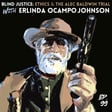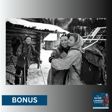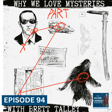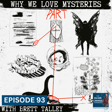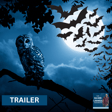Introduction to Vintage Villains Podcast
00:00:00
Speaker
This is the Silver Linings Handbook podcast. I'm Jason Blair. And this is the Vintage Villains podcast. I am Alison Dixon. And this is a true crime bonus episode.
History of Camp Scott
00:00:25
Speaker
It was a warm Monday night at Camp Scott, a Girl Scouts sleep away camp on roughly 410 acres in Northeastern Oklahoma. It was a place where people said at the time there had been many years of joyful memories since the Magic Empire Council of the Girl Scouts opened it in 1928.
00:00:46
Speaker
The camp had been chopped out of the wilderness and was said to be a checkerboard of permanent wooden tent floors set well off the ground. Eight-year-old Laura Lee Farmer, nine-year-old Michelle Heather Guse, and 10-year-old Doris Denise Milner, who went by Denise, were among 140 Girl Scouts who arrived at Camp Scott, which was located two miles from the town of Locust Grove, Oklahoma.
00:01:13
Speaker
They arrived on Sunday, June 12. The girls were drawn from a six-county area that included Tulsa, Mays, Rogers, Payne, Creek, and Osage counties, with most of the girls coming from the Tulsa metropolitan area. They were scheduled to stay for two weeks at the camp, which hosted both Girl Scouts, Brownies, and non-members. The girls were anywhere from the second grade to high school, and each summer enjoyed things like boating, hiking, camping, and fishing.
00:01:43
Speaker
Michelle, Denise, and Lori went to sleep in tent number eight.
Discovery of the Crime Scene
00:01:49
Speaker
The next morning, a camp counselor got up early to begin to prepare for the day by having a shower and saw a body in a sleeping bag around 150 yards, more than a football field's length, from tent number eight.
00:02:03
Speaker
It turned out to be the body of Denise Milner. It was on top of two other sleeping bags that contained the bodies of Laura and Michelle. The story would ultimately tear this Oklahoma community apart, pitting the families of victims and the prosecutors against the native community and others in the community that appeared to distrust them
00:02:26
Speaker
It would raise questions about tunnel vision, forensic science, and the use of circumstantial evidence to weave together a story.
Racial Stereotypes and Vigilante Justice Discussion
00:02:35
Speaker
It would involve stereotypes and racism toward natives that still persist today. We will also discuss the long history of vigilante justice against natives, including lynchings. In fact, in Oklahoma, there were more natives lynched than anywhere else in the United States.
00:02:56
Speaker
And we'll come back to that in a second. And since then, in many ways, local communities, not just Natives, but Whites, Blacks too, distrusted the way that law enforcement handled cases against Natives, just as the Los Angeles Police Department had developed a reputation for corruption that went beyond the way they handled cases with Blacks, but especially with Blacks.
00:03:20
Speaker
Tulsa, keep in mind, was also the home to the 1918 Tulsa race massacre. If anything, I've learned those types of wounds don't heal easily. And as views on race change, the distress spreads beyond the most affected racial minority.
00:03:37
Speaker
It was supposed to be two weeks of swimming, hiking, singing, and bonding for the Girl Scouts attending Camp Scott that June in Mays County, Oklahoma, which had been hosting summer camps for the organization over the last 50 years. That long tradition would come to a horrific end when three of those Girl Scouts were found early one morning brutally slain on a trail not far from their shared tent.
00:04:02
Speaker
The case preyed on many of the fears present in America during this time would ignite the largest manhunt in Oklahoma history and stoke racial tensions between whites and natives who make up a large portion of the state's population. It would also demonstrate the potential limitations of DNA testing to fully pinpoint a suspect.
Research Credits
00:04:23
Speaker
So before we get started, I want to give credit to Jessica Cash of Just the Facts True Crime Research for her considerable help in conducting research for this episode. Some of the sources that we rely on are the books Tent No. 8 by
00:04:41
Speaker
What is it? Lloyd McCoy. Someone Cry the Children by Dick and Mike Wilkerson, who investigated the case. Shattered Justice by J.D. Morrison and Camp Scott Murders by Sue Kelly. Also, we relied on the True Crime Garage podcast series on the case.
00:05:02
Speaker
2022 Hulu Keepers of the Ashes documentary. And another great set of great resources were newspapers like the Oklahoma City. Also in 2017, the Tulsa World spent about a year producing a six-part narrative on
00:05:23
Speaker
you know, what still remains the most infamous cold case and the largest investigation in the history of Oklahoma. And there's also I don't want to go without mention, there is an active and thriving Facebook group called the Girl Scout Murders Cold Case Research.
00:05:38
Speaker
And hopefully some of its members who were invited are in the chat right now who so they can correct us on everything we get wrong. They probably know this case and its players better than anyone. And there is, as you will find, lots of conflicting information out there. In the reporting, there was conflicting information in the pretrial and the trial. So we're just going to do our best and, you know,
00:06:01
Speaker
correct ourselves along the way. But before we jump into that, before we jump into the sort of the present, you know, just an homage to the past and the idea, you know, we come here to do these kinds of podcasts and these kinds of episodes. And I know that for all of this, it's a little bit of entertainment, information, and it's also
00:06:24
Speaker
healing and other things like that, but just honoring the victims and their families. I wanted to take a second to do that before we go on. Back to you, Allison.
Outsider Perspective on Oklahoma's History
00:06:33
Speaker
It's very good. Thank you. Really, before I also commence love bombing, our amazing researcher, Jessica, she's wonderful. I want to acknowledge that this case does have a lot of passion around it.
00:06:47
Speaker
I've seen it during my cruise through some of the online communities, as Jason mentioned, in preparation for this show. So I fully understand after looking through this case, my previous exposure to this was the True Crime Garage episodes. That was like my main exposure to it. But the more you
00:07:09
Speaker
dive into this, you really understand why this passion exists and hopefully you all will too by the time we're done here. This case deals in really sensitive matters around the relationship between natives and Oklahoma law enforcement. And not being from Oklahoma myself, I've only driven through
00:07:28
Speaker
I fully recognize that I will not have all the understanding that comes with living in a state with such a large population of natives, and also has such a thick history of tribal and state interactions. So I would love to be able to travel down there and spend a large chunk of time just kind of gaining that understanding. But that's not quite possible. So
00:07:51
Speaker
I fully admit I'm an outsider here. But anyone who listens to my show knows that this is the angle that I always report from. And this is why I make the study of historical context so important because it informs so much of what we understand and a lot of our own biases as well. And I'm going to do my best to pay respect to that as we report on the facts of this case and, of course, when it comes to the facts.
00:08:17
Speaker
Jessica really delivered for us here. She provided well over 100 pages of research. It was far more thorough than Jason and I could have done on our own with the time we had. Not only that, she walked through us with our outline as we were making it and made sure the boxes were being checked. We're going to link to Jessica's site, Just the Facts. If anybody out there who needs some true crime research done, you can go knock on her door.
00:08:46
Speaker
if you want to delve. Oh, and you already mentioned the true crime research group there on Facebook. There's a lot of people that have spent a lot of years on this case there. Yeah. And before we dive in, I want to show you guys something just to give you some context, because history is always, always important. You know, I had made the point earlier that in Oklahoma, Oklahoma is the state with the most despite not being the largest state by population with most lynchings of
00:09:14
Speaker
natives and for those of you guys who are on the YouTube live, you can see the map that I just put up of natives, blacks, Italians, Latinx people, Chinese and others who are lynched in the broader Oklahoma area. And you can see as you get near Tulsa in Oklahoma City, you get, you know, there's a very large cluster of
00:09:36
Speaker
orange dots, which are blacks, but sprinkled, not even sprinkled, heavily sprinkled all over this are the pink dots, which are natives. Nowhere else in the country do you see this. So it's just something to think about in context that we're dealing with an environment where there was a long history of racial violence against blacks and against natives. So
00:10:01
Speaker
I just wanted to throw that out there before we dove into the timeline. It's all about that historical context, you know? It helps to kind of understand, you know, I've always found that it really helps inform my understanding of what happens in the present when I understand the past, because I think that there are, you know, there are a lot of
00:10:27
Speaker
There I think we have a natural tendency. It's very American to want to forget when something's over. Like we all agree this is wrong, but we don't really delve into.
00:10:37
Speaker
that. So I'll go ahead and get us started with the timeline. So this story really starts before June 12, 1977, with a series of strange things that were later said to have happened in the months leading up to camp. In 1976, there was an incident where an intruder entered a tent
00:10:58
Speaker
and that three campers' mothers were staying in. That three campers' mothers were staying in. In that incident, by the time the camp staff got there, no one was there.
00:11:09
Speaker
Also, reportedly in April, a senior scout named Michelle Hoffman, who was also president camp scout on the fateful days, found a note in an empty box of donuts. The wording on the note is not clear to this day, and it wasn't preserved. But in the pretrial hearing, prosecutors said they believed it said, quote, four little girls would be murdered.
00:11:32
Speaker
Witnesses at the pretrial hearing said that the note was thrown
Pre-Camp Scott Mysteries
00:11:36
Speaker
away and was not reported until after the murders. Another scout reported seeing effigy hanging in the Camp Scott area, although in pretrial testimony, a witness said that the staff had determined that it was just sort of a flippant child's imagination. A child had sort of gone into hysterics and seen a limb strangely hanging across a tree. So there are a lot of weird things going on in the
00:12:02
Speaker
walk up to to the to the murders here. And yeah, I mean, and
00:12:12
Speaker
That's interesting, right? I mean, a lot of this stuff being interpreted through the younger witnesses, people who might see things that, you know, sort of like that peridolia effect of, I see a face in this thing that isn't really there, or like people who see odynistic runes and, you know, blood markings or stick arrangements in Delphi. So there can be an element of that, but it definitely is a,
00:12:40
Speaker
a weird thing, they show up at this camp and they find some of these odd things. That whole thing about the note, I find that interesting because they either were saying like, somebody was just playing a prank. But kids like to do that. They do invent their own scary folklore. Look at Slender Man, for instance, or all kinds of ghost stories and things. There's some element of truth or believability in some of that.
00:13:06
Speaker
that the kids just kind of made it up to scare each other but I don't know what do you think about that. Well I think that you know if I were stepping back and you had told me the beginning of the story as we'll see as we get deeper into it and I didn't know that there ended up being three murders I would have thought this is ghost story.
00:13:28
Speaker
And it just reminds me so much of like the little weird things that would happen when I was in camp as a kid. And I also think like when you're kids and you're going off to camp for the first time, it's really easy to sort of like imagine the boogeyman in the trees.
00:13:45
Speaker
and other things like that. So I'll go ahead and keep on going. This stuff sort of continues into the pre-camp time in the days before the girls arrive. A counselor named Judy Hall reports seeing a strange man in her tent. Hall said that she was in her tent when a man came in, the back of the tent.
00:14:04
Speaker
And she just laid there, not exactly what she saw. Also, during pre-camp in June, counselors noticed damage to one of the tents that had been repaired by the time the girls got there, including at minimum a rip in the fabric of one of the tents.
00:14:23
Speaker
I'm the day camp was supposed to start. Some of the counselors arrived early a couple hours before the buses of kids and while unloading their luggage into their tents, they noticed somebody cut the flap off of tent number six in the section that we're going to be talking about. It just seems like I mean, if this was all.
00:14:43
Speaker
As it sounds, I mean, it sounds like somebody was living in and around the camp during the time it was sitting vacant between camping trips. I wasn't clear how often the camp was being through. Well, that's funny you said that. My thought was, there's some camp counselor, Jack and everybody else.
00:15:03
Speaker
Honestly, it's very possible because I don't know if a transient type individual would be out there because it's out in the middle of nowhere. I know a lot of people around the area knew those woods really well, but they probably already knew that it was an active campsite place and there was always groups of people coming in and out of there.
00:15:27
Speaker
It's it's kind of interesting and they and they've been doing this for 50 years. There was no history of things like this happening before I mean, I wasn't able to you know clear on whether or not that was possible If this had happened before and they just kind of said ah, it's just somebody messing around whatever Well, I think human nature right like yeah your hoof prints you're not thinking zebras you're thinking like horses are coming by maybe yeah, um, and so I you know, I think
00:15:58
Speaker
People probably thought it was spooky, but. But yeah, you wouldn't probably wouldn't think much of it like I would. Yeah, I I wouldn't think much of it. Yeah, yeah, probably not. I would probably need to see a little more, but I think too back then just people were like kids will be kids. Well, also I think in retrospect, right? Like sounds like somebody was living around there. Mhm, so.
00:16:26
Speaker
I'm going to go ahead and pull up another slide for you guys to show you the girls. And we'll go ahead and introduce you to them. So we've got
00:16:41
Speaker
We're on June 12th, 1977. And so about 140 Girl Scouts arrive at Camp Scout this day for two weeks day at a stay away camp. So they're all staying away from their parents, many of them for the first time. So for 10 year old Denise Milner, this was her first trip to Camp Scout. Denise lived with her family in Tulsa. And she was said to be a straight A student
00:17:08
Speaker
who was also shy and a nervous girl, and she was worried about going to camp. On the bus to that camp, we had mentioned her before, was one counselor, a senior scout named Michelle Hoffman, and she'd later say that Denise already seemed homesick before arriving at camp. She said in the Keeper of the Ashes documentary that she could tell that she was not happy about being there.
00:17:36
Speaker
But Michelle sat with her on the bus and Denise's mother, Betty Milner, asked Michelle if she could help find a way for Denise to call home. And Michelle promised Betty that she would look after Denise. Another counselor described Denise as an old soul who especially wanted to find friendship while at camp.
00:17:58
Speaker
So the buses of the girls arrived, and this is Denise, for those of you who are on the live. So the buses of the girls, they arrived between 2 p.m. and 3 p.m. The elder counselor at the camp testified in the pretrial hearings that that's when this happened. Dee had been a Girl Scout since second grade, had become a counselor about two years earlier.
00:18:23
Speaker
The camp's director, Barbara Day, put their arrival time squarely at 3 p.m., according to her testimony. So according to D. Elder's testimony, all the girls were taken over to the areas where they would be camping around 330 or 4 p.m. Once the girls all arrived at camp, they were split into different areas with 27 of them placed in what would be known as the Kiowa Unit.
00:18:51
Speaker
The girls, and I will pronounce everything wrong, the girls were, according to the book, someone cried the children, allowed to select their tentmates. And after selection, Laurie, Michelle, and Denise ended up together. And for those of you who are in the live, this is Laurie.
00:19:14
Speaker
This is Michelle. And that last one was Denise. And what happened, the book says that the girls were left because they didn't know anyone else in the unit and appeared too shy to sort of make friends on the bus. But the girls were introduced to each other and the counselors felt they really got along and thought they would make a good match. So the
00:19:39
Speaker
The unit that they were in is the most isolated unit in the camp. The tents were arranged in a horseshoe shape. And each group was sleeping four to a tent other than Lori, Michelle, and Denise. The girls were taken to tent number eight. And I want to say something real quickly about this. You will find that it is referred to at different points. It's tent number seven, tent number eight. We're going to go with tent number eight for this episode.
00:20:05
Speaker
But they were taken to ten number eight where they unrolled their sleeping bags and according to someone cry the children the elder said the girls in that unit had finished unpacking their belongings around four thirty pm. So ten number eight you know is probably the furthest or it is the furthest and away from the counselors.
00:20:25
Speaker
And it could, depending on who you listen to, either not be seen or only partially be seen from the counselor's tent because of a kitchen, a shower block, some foliage. And for those of you who are on the live, we'll go ahead and show you
00:20:42
Speaker
The area this gives you a map you can see here Locust Grove You know the town that's two miles away from Camp Scott but this is the cookie trail which leads the road that leads into Camp Scott and you can see the red spot there is the unit that the girls are all in and you can see how If we go in a little bit closer, you can see how it's truly out of all the units the most isolated
00:21:12
Speaker
The most isolated unit you know isolation is kind of hard to measure because it all depends on the circumstances and what you're looking at but it's fairly isolated compared to the compared to the other ones.
00:21:25
Speaker
And you can see some of the other units that are near it are going to become important parts of the story. According to the book, dinner was generally served between 6 p.m. and 7 p.m., but on the 12th, it was extended to 7.30 p.m. And at some point during dinner, rain started coming down heavily. It eventually turned into a thunderstorm.
00:21:47
Speaker
But before bed, some of the girls engaged in some horseplay with flashlights. According to one of them, 10-year-old Amy Sullivan, another first-time camper, at about 8 p.m., the counselors held a camp meeting with the girls in the kitchen, conducted a head count, and concluded that all the girls were present.
First Night at Camp and Letters
00:22:08
Speaker
At that time, they realized that there was a bit of a mix-up.
00:22:12
Speaker
that a girl who was supposed to be in the unit and the area that they were in was placed in the Comanche unit, which you can see on the map, is due south, through the trees due south of that one. And due to the thunderstorm, the days planned activities were canceled and the girls went back to their tents.
00:22:33
Speaker
They were really just going from dinner to their tents, little bit of horseplay, very normal camp day stuff. But by bedtime, Amy said that the campers couldn't see or hear anything. It was so dark. Yeah. And that night, though, Denise, Michelle and Laurie set up writing letters with a flashlight to their families and the letter to her parents. Denise wrote, Dear Mom,
00:23:03
Speaker
I don't like camp, it's awful. The first day it rained, I have three new friends, Glenda, Lori, and Michelle. Michelle and Lori are my roommates. Mom, I don't want to stay at camp for two weeks. I want to come home and see Casey, who's her sister, Cassie probably, and to everybody, your loving child, Denise Melner. And that's a letter I could imagine writing when I went off to camp.
00:23:32
Speaker
especially the first night. I mean, I, I didn't do a summer camp traditionally. I did do like, um, band camp. And I think I probably did some church, uh, overnight or go away kind of things, maybe a couple of times. But when you're that age, it's for me, uh, as a kid, like I almost got held back in kindergarten because I was terrified to be away from my mom, uh, for too long. I would cry every time I went to class, but I mean, I was like four. Um, but even at eight, I think I,
00:24:01
Speaker
was still afraid to sort of be away from home overnight, at least for the first couple of nights. And so imagining being in the woods, and these are thick woods, by the way, it's dense foliage and things are spaced out quite a bit. If you watch the Keeper of the Ashes documentary, you can see a lot of footage of this camp from the archives of when this happened. So I can imagine, especially with the darkness and the unfamiliar surroundings and the unfamiliar people,
00:24:31
Speaker
Yeah, I mean, I could see why Denise is, you know, she was already kind of an old soul and a little shy. I could see why she really wanted to go home. My parents sent me away every summer. And as soon as I had kids, I began to understand why.
00:24:47
Speaker
So, eight-year-old Laurie Falmer also wrote a letter to her mom, dad, and siblings describing meeting two new friends. It said, Dear Mommy and Daddy, and Misty and Jolie and Chad and Kaylee,
00:25:03
Speaker
We're just getting ready to go to bed. It's 7 45. We're at the beginning of the storm and having a lot of fun. I met two new friends, Michelle and I got Michelle and Denise Miller. I'm sharing a tent with them. It started raining on the way back from dinner. We're sleeping on cots.
00:25:27
Speaker
I couldn't wait to write. We're all writing letters now because there's hardly anything else to do with love. Lori also wrote a similar letter to her aunt. The letters never made it in the mail.
00:25:44
Speaker
I want to provide another bit of cultural framing here because you're already hearing this lead up, you know, or in this setup of a lot of innocent people, children arriving to prepare for a summer camp and immediately finding signs of things that are amiss.
00:26:02
Speaker
And it might be reminding you of a certain horror movie franchise featuring a guy in a hockey mask who kills a bunch of teenagers at camp crystal lake and to be clear the girl scout murders happened in nineteen seventy seven.
00:26:17
Speaker
And they were adjudicated the following year or in 1979. So a year and a half later. Friday the 13th though was released soon after this in 1980. And its popularity brought in a glut of similar summer camp slasher films very soon after like Madman, The Burning, and Sleepaway Camp.
00:26:38
Speaker
Many have suspected that this case in particular is what inspired the creation of that genre, but the writer of the original Friday the 13th film, Victor Miller, he was quoted
00:26:54
Speaker
as saying that he'd never heard of the Oklahoma Girl Scout murders before writing his screenplay and that he was trying to depict a secluded setting where young people would realistically find themselves. So that would, of course, be a summer camp. And I'm willing to believe this. And when you see the maps, of course, in the pictures of this place and how this camp was laid out, it's very easy to see how art can accidentally imitate life. Actually, I have I have a bit of a theory about that.
00:27:24
Speaker
I think writer's imagination and killer's imagination are not that different. You know, you look for the opportunity to write the scary story. The criminal looks for the opportunity to harm someone. It all comes from the same place. So what I'm saying here, guys, is don't be friends with writers. I can vouch for that.
00:27:46
Speaker
All right. So one of the things that I'd say about that to that point, I do think that's totally plausible, but I think it hasn't even gotten as scary as it starts to get yet. Right. Because you can see on this map, if you take a look at this map.
00:28:03
Speaker
You can see where the camp's located. You can see some areas around that. You can see what looked like some trails and creeks, and we'll come back to those at some point. But at some point between 10 p.m. and 10.30 p.m., Dee, the counselor and the unit leader, said she went to each tent in her group and told all the girls to go to sleep.
Mysterious Noises at Night
00:28:29
Speaker
And supposedly, at that point, it was finally silent. But this was the beginning of another set of concerning issues. The front gate of the entire camp was locked at 10.45 p.m. Not long after, the three unit counselors fell asleep. Job well done, everybody safe and sound, or so they thought.
00:28:50
Speaker
An unnamed counselor from the command unit, the unit just north of theirs, later reported seeing a dim light behind a tree as she walked back to her unit to use the bathroom. The counselor is also reported to have pointed her flashlight in that direction because she knew there wasn't supposed to be any light coming from that area. She turned her light off and waited a few minutes later.
00:29:14
Speaker
She saw the dim light return and she pointed her flashlight at it again in the woods and the mystery light went off She turned her flashlight off again dim light returned But this time she became really uneasy and even fearful and after a few minutes switch her flashlight back on and ran back to the safety of her fellow counselors at the Comanche
00:29:36
Speaker
Oh, every time I read about this or see it and like when they mentioned in the documentary, chills. I've been camping a lot and going to the bathroom when you're camping, you go to that little bathroom unit and getting back to your tent from there is just when you're young. I mean, for me anyway, prone to anxiety. Yeah, I could put myself so easily in that moment and I, yeah, I can absolutely feel her fear and unease
00:30:04
Speaker
Yeah, and I from camp, I remember even the counselors, we always at night would go in pairs, everything. There's it would be in groups in pairs. But part of why that may not have happened here is they have walkie talkies, the counselors that although we'll find out later that the walkie talkies were not exactly working the way they were supposed to. So at some point in the I'm pronounced is definitely wrong in the
00:30:29
Speaker
There were sounds of screaming scouts running through the darkness.
00:30:36
Speaker
Counselors ran over to see what had happened and one frightened child explained that she was walking from her tent to the bathroom and someone had grabbed her by the raincoat. Other girls told counselors that night that someone or something was stalking around their tents. One camper said that on her way back to the tent, she had dropped her towel and when she bent over to pick it up, her flashlight beam hit the legs of a man wearing khaki pants.
00:31:04
Speaker
This is building, honestly, terror right now. Right, and so the counselors, they search the area and they find nothing. Then there's this incident near the Kiawa tent, number five.
00:31:19
Speaker
Carla, one of the counselors, Carla Wilhite, a counselor, was woken up around 1.30am by girls giggling in tent number five. She yelled at the girls, telling them to go to sleep, and as she was shining her light on their tent, the elder, the other counselor, woke up.
00:31:35
Speaker
As they were sitting awake in their cots, Dee and Carla heard a noise that caused each of them, they said, to give each other a questioning look. They described it as a low guttural moan. And I want everybody to remember those words, low guttural moan.
00:31:52
Speaker
They both said they got up to go outside and they both walked toward tent number five where it seemed like the sound was coming from. Carla suggested Dee walk toward the moaning sound to see if it was an animal while she checked on tent number five. However, Carla changed her mind, as I probably would have too, and decided to investigate the noise herself before checking in on the scouts. The terrible sound continued as she walked toward the road that led to the unit.
00:32:20
Speaker
When she reached the road, she pointed her flashlight in the direction of the sound. When the light beam hit the trees, the moaning stopped.
00:32:30
Speaker
So Carla walked back to the tents and the moaning began again, beginning to see a bit of a pattern here. She turned around and she stopped. So Carla walked back to the tent with Dee, checked on tent number five together, then they returned to their quarters. As Carla laid down, the moaning began again and continued as she fell asleep.
00:32:51
Speaker
Dee remembered it slightly differently, saying she believed that they were woken by a door slamming that was shut on the bathroom and not by the girls' giggling. She also didn't testify to hearing the low guttural moan, but Carla thought the bathroom slamming happened earlier and she heard the moan.
00:33:11
Speaker
So Jason, real quick, could you put the the map back up of the tent layout of like the diagram? You mean? Yeah. Yeah. OK. So an Oklahoma State Bureau of Investigation investigator Michael Wilkerson, who is the one who co-authored Somewhere Across the Children, he testified that one of the counselors told him a girl in the unit heard voices whispering in the night.
00:33:39
Speaker
So Beverly Huff, an investigator for the district attorney's office, later testified that she'd interviewed all of the girls in the unit, but they said that they had heard nothing. She would also testify that she interviewed Kristen Jones, a girl scout, pow pow unit. And Kristen told her counselor that she had heard male voices that night about six trees back from her tent. OK, so this is to me, this is kind of interesting.
00:34:09
Speaker
So we've got someone in the woods with a light turning it on and off as someone points the light at them. And it's a dim light. A dimmer light. Right, a dim light. You got someone, no light, but moaning in the woods and as people approach them,
00:34:30
Speaker
They stop moaning. And then you have people sort of saying that there were other people stalking around tents. And one of the really easy things to think is that everybody's imagination is running wild. Or the other piece is, is this all in retrospect? Are people remembering or misremembering things in retrospect? But some of these things were reported that night, which I thought was kind of interesting. So it's not all...
00:35:00
Speaker
sort of a retrospective in the sense that we have this ability that as humans when something bad happens to start to look for the clues and the signs and sometimes see signs that weren't really there or exaggerate things, but because some of these things involve counselors and they were reported that night, that tends to lend some credence to it.
00:35:21
Speaker
Also, they did more steps. If it was just like, I was laying there and I heard this moaning, but they didn't do anything, but they just heard it. But the fact that they walked toward it and it responded to their flashlight or their motion and it kept happening, this repeated event to me suggests
00:35:42
Speaker
not so much like a confabulation or whatever you want to call it, where you're sort of thinking of details in the retrospect and the same. It seems more like an active memory.
00:35:55
Speaker
than anything. Yeah. Yeah. And the fact that some of it was reported to other counselors and the director that night, you know, that lends even more credence to me. So at approximately three a.m., a girl in the Cherokee section of the camp, which is another unit, heard a scream. She said she sprang up from her cot and thought the scream came from the direct direction of the Kiowa unit.
00:36:23
Speaker
um which was roughly about two city blocks away although i'm not sure what a city block means because the city block in new york two city blocks might be another planet and tulsa it's a little uh tighter and actually in tulsa it's different because if you had north and south and tulsa the blocks are really small had east and west they tend to be fairly large so i'm not sure what they mean by a city two city blocks but the girl said she checked her watch
00:36:48
Speaker
and she woke the other girls in her tent. They didn't hear anything, didn't know what to do, so they went back to sleep. Around the same time, a girl in the kwa-pow unit, the one closest to Kiawa, heard a girl scream. She thought she heard someone screaming, Mama, Mama. The odd thing is that all the Kiawa unit
00:37:13
Speaker
tents would be closer to tent number eight than the unit that this girl was in. So after hearing nothing else, she went back to bed. Another scout would later report a scream around 3 a.m., both of which would factor later into a civil suit against the Girl Scouts.
00:37:34
Speaker
And another counselor in the quad by unit, however, thought the scream came from a girl who was sleepwalking and had no recollection of it. And so you're already beginning in my mind to see some clues that will that will play out later because, you know,
00:37:52
Speaker
When you're at camp or when you're at school or as a child, they're operating, they call it in loco parentis. They are responsible for you like a parent is. So it's not just that they can throw you out and let you go. But so, you know, I think what you'll find in the story that people are thinking about civil liability probably a lot earlier than you would suspect.
00:38:17
Speaker
Yeah, that was an additional ingredient in this little soup here that I was curious about, you know, going into the research of it was what happened with the Girl Scout organization, you know, legally, in the sense because this is their camp.
00:38:37
Speaker
We'll definitely touch on that a bit more going forward. But the counselor, Karla Wilhite, she woke up to her alarm at 6 a.m. according to her pretrial testimony. She was going to have a shower when she saw Denise Milner's sleeping bag about 150 yards from tent number eight.
Details of the Crime Scene
00:39:01
Speaker
That's a distance. You think of one and a half football fields.
00:39:05
Speaker
in the direction of the Quapaw Unit. And she wondered why the girl was sleeping away from her tent and then noticed it looked like more than one sleeping bag was lying there. Denise was found on that bag and it was near the two others which contained the bodies of Lori and Michelle, though it would be a few minutes before that particular discovery was made.
00:39:32
Speaker
And of course, Jason is putting up some images on the YouTube live of the tree where the three sleeping bags were found. And the counselors, Carla, Dee, and Susan quickly did a head count.
00:39:49
Speaker
of the girls. They, you know, raced back and they put their hands on each girl just to make sure they were there. And Carla and Sue began at tent number 2 and Dee began at tent number 8. So it sounds like they were kind of working toward the middle. And you can see on the diagram there the distance between the counselor's tent and the other tents. Things are pretty spaced out here, you know.
00:40:13
Speaker
But Dee, she quickly came running back and said that tent number 8 was empty. And Carla was reported to say that maybe they're asleep in someone else's tent. I mean, if somebody got scared in the night, maybe they, you know, people move around. If you think about kids at a slumber party, things like that tend to happen as well, you know.
00:40:35
Speaker
But Carla was reported to say that maybe they're asleep in someone else's tent, and so they continued to count. Carla went back to tent number eight and noticed blood on the floor and on the mattress. The sleeping bags, to answer a viewer question, she was asking where the sleeping bags were found.
00:40:57
Speaker
I believe I would have to scroll. Alison, you haven't learned. You don't indulge them on the live. You answer in the chat. Oh, you're absolutely right. Well, cut that, cut that, cut that. Jessica, grab that one. The sleeping bag was discovered 150 yards from tent number eight in the direction of the Quapaw unit.
00:41:19
Speaker
And thank you, Jennifer, because our editor is going to really thank you for getting that one in. But she quickly came running back and said the tent number eight was empty. Carla was reported to say that maybe they're asleep and someone else is tense, so they continued the count. And that's when she found the blood at tent number eight.
00:41:40
Speaker
And Carla then ran to the nurses' quarters, telling Susan and Dee to keep the girls in their tents. Susan instead then went to where Carla found the bodies and screamed as she bent down and touched one of the other lumps in the sleeping bags, and she felt no movement. And according to my recent watch of the Keeper of the Ashes documentary,
00:42:04
Speaker
My own interjection here is the girls that were still in the sleeping bags, Lori and Michelle, they were at the very bottom of the sleeping bags, which suggests that the killer had slung the bags over his shoulder.
00:42:22
Speaker
sort of like a, like a gunny sack kind of thing. And so, so they just kind of weren't easily detected. At that point, if you look at, we don't have, I don't think we have pictures of the actual sleeping bags at the base of the tree, but they are in the documentary. And you can just get a sense of, it just looks like a pile of sleeping bags there. So
00:42:44
Speaker
I don't think they immediately assumed that the girls were inside the sleeping bags, although that was a point of contention later in the investigation. But Dee then told Susan to return to the tents to ensure the scouts stayed inside while Dee ran to her car at the staff house and drove to the director's house. According to the director, she said they had to run and drive because the counselor's walkie-talkies were not working.
00:43:12
Speaker
But the claim in the book shattered justice that Barbara Day ran the Girl Scouts director, or that she was the Girl Scouts director in Tulsa, sorry, ran to the Girl Scouts director in Tulsa before calling the police. However, Barbara testified later that she phoned the highway patrol first and then went to the Girl Scouts director. So there's a little bit of discrepancy there on like who was called first, who was brought in first.
00:43:38
Speaker
Can I tell you a funny story? I got a good story. So this reminds me. So like the whole idea, I was not at all shocked that when I was first reading about this part of the story, I was like, is she going to call her lawyer first or is she going to call her police, the police first?
Miscommunication by Girl Scouts Organization
00:43:57
Speaker
Because I remember this time when me and the boys, Jay and Sean, and I think Bonnie and her mother, we were at a car dealership.
00:44:06
Speaker
And Jay is like deathly allergic to bees and he got stung by a bee. Right. And so we ran to the general manager to get them to call for an ambulance. Right. And so the general manager calls somebody over one of his people and tells them probably to call the ambulance as he picks up picks up the phone to call the dealership's attorneys. I mean, like my head was about to blow off.
00:44:32
Speaker
But one of the things that I realistically realized that as soon as they found out that there was a dead scout, the Girl Scouts were probably thinking about their liability as much as they were thinking about the rest of it. And I think you see that in what happened in that next step when they call the parents and tell the parents that, sorry, your daughters have died in an accident.
00:44:59
Speaker
on camp and they didn't need the parents found out they were murdered on TV.
00:45:05
Speaker
Right? Yeah. Yeah. And so many factors at play there, especially when you're talking about an organization. And an organization has multiple heads clustered together into one. So whenever they're brought this huge information, all those heads are working independently and simultaneously. So I can imagine they're trying to cover every base at the same time.
00:45:30
Speaker
And I think part of it is people like to believe they know what they would do in certain situations when their back is against the wall. Very often, even in very sad situations like this, what people do is they think about themselves.
00:45:44
Speaker
And then you're thinking about the logistics too, right? I mean, my husband was in a car accident about it was about eight years ago and he called me when it happened. So I knew he was alive and he said he was safe. But the first main thing that went in my head was, Oh my God, I got to call Geico.
00:46:02
Speaker
and get this ball rolling here, you know what I mean? It wasn't like I wasn't thinking about my husband's safety and well-being. It was like, oh crap, I have to think about my insurance and all that. So it kind of feels like, yeah, we celebrate that things turned out okay, but you have to, there's a lot of things you got to think about at once, and it's not as romantic or always this, like,
00:46:24
Speaker
fuzzy, sweet thing. But the Girl Scout executive, Bonnie Brewster, called the parents of Lori, Michelle, and Dee and told them their daughters had died during the night in an accident. That was kind of a miscalculation, I think, on their part. They probably shouldn't have described the manner of death that they didn't know it, but they probably just, again, when you're telling somebody news like this that their child is dead, you kind of probably want to
00:46:51
Speaker
have this tendency to fill the void with words to explain something so horrific, right? It was only after turning on the television, though, that the parents heard the word murder, uttered, and they were furious with the Girl Scouts. Again, I get it, though. That is not the way you want to find out.
00:47:14
Speaker
But just around 7 a.m., three county sheriff's cars and the local medical examiner was the passenger in one of three ambulances that arrived there close behind the police. Wilkerson, the OSPI crime bureau agent, arrived on the scene that morning and was upset that no one had already opened the sleeping bags to check for signs of life. The bags were in fact still unzipped.
00:47:43
Speaker
We're already seeing some delays, but again, I think one of the people in the chat, I think it was Leslie, mentioned that we wanted to know how old these people were, these counselors. Then a lot of them were just in their early 20s. They were pretty young and a lot of these were senior scouts that were transitioning into becoming counselors. We got a lot of young people running the scene here in addition to all these other cooks in the kitchen trying to figure things out.
00:48:10
Speaker
When did we get to the point where you're the one making excuses for people? And I'm like, I don't know, man. Like, I don't know. Like, no, no, no. Maybe it's my bias, but you find three dead bodies in a camp for me. The only thing I will be thinking about is finding every other girl.
00:48:32
Speaker
Finding every other girl when I was 16 and when I'm 60, it would still be the same. Finding every other girl and making sure they're safe.
00:48:41
Speaker
And they kind of did. And they did. I mean, they were running back and doing counts. I mean, maybe. But the only thing the only thing I would be thinking about, I wouldn't be thinking about lawyers. I wouldn't be thinking about what I'm going to have for dinner. I would be thinking about how do I. I'm not saying what I would be thinking about and doing, but I am trying to probably put myself in the heads of these people that are running this.
00:49:04
Speaker
I'm the guy who have I'm the guy who runs this empathetic podcast that like I don't know wants to understand the depth of this now I would want to know I my big question is a um and my big complaint here is a the way that they inform the parents I think that that was very sloppy and insensitive um and b the they didn't check this the sleeping bags sooner and even in the documentary they didn't really
00:49:31
Speaker
have a great explanation for why other than they just thought it looked like sleeping bags and the girls were kind of bunched up in the bottom of them. So it wasn't entirely apparent at first that there were any bodies in the sleeping bags at all. So it took a minute, I think, for them to even really realize that, oh my God, we have three bodies here, not just the one.
00:49:52
Speaker
And you can see up here the distance on the screen, the, you know, basically, essentially, you're talking a fair distance between the victim's tents and where the counselor's tents are. And you can see the horseshoe shape if you're on the screen, if you're on YouTube. You can see the horseshoe shape of the tents and that the girl's bodies are found far from where
00:50:20
Speaker
their actual tent was. So quite a bit. Yeah, yep. So what happens is eventually the investigators arrive on the scene, they unhook the remaining flaps of tent number eight. And its cots were said to have been sort of carefully moved outside the tent, the cots belonging to Michelle and Lori were said to be saturated in blood.
00:50:44
Speaker
All four of the cots that were there were sprayed with fingerprint powder, and only one print was lifted from a cot, and it couldn't be matched. Technicians began to examine the inside of the tent, including some wood taking photographs. And as they went, there was blood spray on the inside of the tent walls, which seemed to suggest that at least Michelle and Lori had been struck.
00:51:10
Speaker
with some sort of blunt instrument while still in their cots. There was a footprint of a military-style boot at the scene, another bloody footprint of a tennis shoe. Investigators had identified that Denise and Michelle both had rope tied around their bodies. The rope on Michelle reached around the back of her body and was tied on both wrists, and her wrists were nearly at the side of her body with a knot on each of them.
00:51:38
Speaker
The rope was tested against rope from buildings at Camp Scott and found to be inconsistent. Denise's body had black duct tape around her chest, over her clothes, and around her wrists. She also had rope over her wrists, tied behind her body, with one hand overlapping the other. The medical examiner described it as a three strand spiral cord attached to the front of her pajama top.
00:52:07
Speaker
that was also taped on with black tape. There's also a piece of terry cloth like material across and under her chin that was connected by some other cloth material similar to that of like an ace bandage or something like that touch on her neck. Lori didn't have any ligatures or
00:52:28
Speaker
tape on her body. And so one of the things that also happened that we don't really address is there does become, as the investigators are coming in, a mad rush to get the other girls out of camp and back to Tulsa and other spots like this. And for those of you here, here's an image. You can see that the news media had already caught wind.
00:52:53
Speaker
This is an image of the family members picking up their kids as the buses arrived in Tulsa. The one in the middle, they were getting the kids out in buses, cars, and anything that they could to get the kids out of there.
00:53:11
Speaker
And I also wanted to mention in the Keeper of the Ashes documentary as they were describing what the state that the camp was in in between when the bodies were discovered and the police had arrived and before they started taking the kids out of the camp, they were doing everything they could. This was according to, I think, Dee Elder, one of the counselors who was interviewed.
00:53:34
Speaker
to keep the kids distracted because they didn't really want to scare them or let them know they knew something was up. They didn't know the details and she described the sound of the campus as police were arriving and they got out of their cars and they could hear the Girl Scouts singing and they could hear their voices through the woods because they had taken them on a hike to try to distract them and get them away from everything and they were singing songs.
00:54:02
Speaker
It was this very sad dichotomy of this awful event that had happened and this innocent beautiful sound of singing children in these woods. That just hit me as I was watching it too.
00:54:21
Speaker
And you know, I mentioned Lori didn't have any ligature tape on her body, but she was also deceased on the evening of June 13th. So we're talking about the next day at about 945 PM. Three officers took a report from a man nearby on a ranch who said that the night before there had been a burglary there.
00:54:44
Speaker
There was also a footprint of a military-style boot left at the scene. That man, Jack Shroff, said he had been burgled repeatedly and not reported it because normally it was only food and small items that were stolen.
Caves Reveal Evidence
00:55:00
Speaker
Then a few days later, on June 16th, two squirrel hunters
00:55:04
Speaker
named Willis Ray Thompson and his brother-in-law, John Colvin, discovered a cave about three miles from Camp Scott. And at least three caves were eventually found. And for those of you guys who are here, you can see the map of the caves above. And you can see on the right side of the screen, that's Camp Scott. And you imagine vertically the Kookie Trail runs. And those are the three caves that they had found
00:55:34
Speaker
nearby and you can see also on that map where the ranch fits between what they call cave one to the south and then cave three and cave two to the north. So Thompson and Colbin the squirrel hunters said they had found two empty red bread sacks full of flour under some rocks at the entrance to the cave that they had found
00:56:02
Speaker
They also found newspapers at the scene and someone had to use newspapers to wipe themselves after defecating. The newspaper was later found to bear the same date
00:56:18
Speaker
as newspaper found in a flashlight and the date was April 17th, 1977. So Thompson and Colvin took the flower to Camp Scott and spoke with some law enforcement who were still there and that led the law enforcement back to the cave. They also said they found two wadded up wedding wedding photographs and
00:56:43
Speaker
in a cave that authorities later linked to a man named Gary Leroy Hart. They had found a records clerk at the Granite State Reformatory. It's also called penitentiary in some places who had said Hart had assisted him in the development process, which in theory meant he could have
00:57:07
Speaker
taking copies for themselves. In one of the caves, investigators found a pair of sunglasses and a glasses case that were later identified as being stolen from camp counselor Susan Imri. There was a roll of masking tape that was said to match the tape around the flashlight that I just mentioned and that it was
00:57:30
Speaker
beautiful based on a tear mark in the flashlight. And I'm not sure whether there's all that much validity to tool markings on. I have seen some interesting cases sort of as an aside, like in my sort of watching forensic files days, where I've seen cases be solved by being able to match
00:57:55
Speaker
say a garbage bag to the role that like the garbage bag was torn from and then they were able to actually find out like what lot that was because of how it was identified. I mean, it was, I can't remember the exact case, but I do very much remember that particular element. Maybe my fellow true crime junkies out there would know. But
00:58:16
Speaker
As far as tape goes, because the way tape tears when you're tearing tape, it doesn't seem quite as consistent as something like a manufactured role of garbage bags that have a seam already cut into them for you on a machine. When you say indisputably and in our outline, you have that in quotations.
00:58:39
Speaker
scare quotes. It's scare quotes. Thank you. That, yeah, there's a little bit to be doubted, I think, about this. You didn't have to sell your basin on that. Absolutely. But the world of tape that had the green plastic attached, because there was a talk, though, that the existence of sort of this hooded flashlight, the witness saw a dimmed flashlight, and they were hooding their flashlights. I think there was like
00:59:04
Speaker
to keep the dentist, it's where you cover it with plastic and you cut a little circle out just to let a little pinhole of light, a little bit of a beam through, that's that whole process. They also said they found two wadded up wedding photographs in a cave that authorities later linked to a man named Jean Leroy Hart.
00:59:22
Speaker
So some of the items recovered from the caves were linked to the property of a local farmer and others were linked to a burglary at a grocery store in a small town called Sam's Corner. There was also another burglary at a nearby grocery store where they found type O blood.
00:59:42
Speaker
A military boot that was consistent with the print at the Shroff property, the grocery store burglary at Sam's Corner, and tent number eight was found in one of the caves. Law enforcement estimated that the time of deaths of the girls was somewhere between 2 AM and 5 AM. And initially, the medical examiners didn't detect any sperm. But they did an acid phosphates test
01:00:08
Speaker
which is used. It's got an enzyme that sort of frees attached groups of other molecules. It was used and they finally identified sperm. The test came out positive on Denise and Michelle and there was a negative of that time on
01:00:26
Speaker
Lori, so additional evidence found near the scene included a red and white six volt flashlight, which had some kind of green, dark green plastic with a trash bag.
01:00:41
Speaker
And it was taped with white masking tape to the front of it and a whole cut in it. Black duct tape was found that was believed to have come from the nearby residents of Jack Shroff. A rope, a pair of glasses, a glasses case that was believed to belong to Carla.
01:01:06
Speaker
a guitar capo, a girl's hair piece with blue balls attached, and a crowbar, and of course the flashlight, the six-volt flashlight being an important piece of it. Allison, did you want to say something?
01:01:20
Speaker
Oh, no, I was I was curious if that was meant to be a nine volt or a six volt flash. I was not sure. But either way, it's a small six volt. I think I think it's a six volt. I wasn't sure. Yeah, I'd never heard that before. So yeah, the research says six. The article says six. So sweet. Okay.
01:01:37
Speaker
So investigators also concluded that Denise and Susan's purses had been stolen and that Carla and Susan, the two counselors' glasses had been stolen. One witness later testified that her unit's leader's purse was also stolen. So investigators found two bloody shoe prints inside and outside
01:02:01
Speaker
One print was from the tennis shoe, like I said, and one was from a military-style boot. So the counselors, Dee Elder, Carla Wilhite, and Barbara Day, were wearing tennis shoes in the morning, and Carla said that tennis shoes were standard fare for campers and counselors. One counselor, Susan Emery, said she was wearing rain boots, but then changed back into her tennis shoes before this happened.
01:02:30
Speaker
So others said they didn't see anyone wearing shoes that could have made the print seen in the tent. So several strange events had happened in the camp in the weeks before. And eventually, these events that happened in the weeks before and afterwards lead to our suspect.
Prime Suspect: Gene Hart
01:02:51
Speaker
Yes, and a 33-year-old man, a Cherokee man named Gene Leroy Hart, who quickly becomes the prime suspect. One of the officers at the pre-child hearing would testify that he was involved in investigating a burglary at Jack Shroff's property nearby
01:03:12
Speaker
where two-inch rolls of black duct tape and rope had been stolen. Some bottles of paps blue ribbon beer were also stolen from the Shroff property and three bottles of the same brand were found southwest of the Girl Scout camp. The sheriff testified that he spoke to a man named John Fleming who lived in Locust Grove and worked on flashlights. He said he was familiar with the six-bolt flashlight or one very similar
01:03:39
Speaker
recovered at the scene and he said he had seen the flashlight at the camp on Spring Creek in the possession of a native male who was known as Sonny. And Sonny was a nickname, a family nickname given to Gene Hart.
01:03:57
Speaker
And Spring Creek is located to the southwest of Camp Scott and Snake Creek, which borders Camp Scott. And we'll put that up on the screen there for folks to see. John Fleming said that he had put newspapers in the flashlight battery compartments and newspaper was recovered from the battery compartment of the flashlight.
01:04:20
Speaker
I'm not really sure why newspapers put in the battery compartments, maybe to hold the batteries in place. Maybe they kind of jiggle loose or whatever. That's my guess. Or maybe it's water to keep water away from the batteries. Fleming was said to have told investigators he had worked on flashlights, including a red and white flashlight at Jean Hart's mother's home. Jean went by the name Sonny, as I mentioned a second ago. The sheriff showed him the flashlight that was found and Fleming said he had worked on one
01:04:50
Speaker
like that. It's kind of an interesting and very specific thing to be able to remember. Fleming told investigators that he had visited the camp on nearby Spring Creek and he saw a native male named Sonny at the camp with the flashlight in late August or early September of 1976.
01:05:09
Speaker
And that the flashlight was sitting under a tree as well as a homemade spear gun made from surgical tubing, a pair of tennis shoes, a pair of military type jungle boots, a green piece of canvas material that he believed was being used as a tent or a shelter. Fleming said that Sonny also had a hand axe that law enforcement was never able to recover.
01:05:35
Speaker
Fleming said he drove Sonny, or Jean Hart, to Lakewood, Oklahoma, and left him at a stoplight as you entered the town from the north where a workman's boot store was located.
01:05:51
Speaker
Oh, yeah. And just to clarify, our researcher said that Fleming claimed that the newspaper was to improve the contact with the battery. So, yeah, that was kind of my guess, too. Yeah. Thank you for that. Fleming said, yeah, he drove Sonny to Tahlequah, Oklahoma and left him at a stoplight as you entered the town from the north, where Workman's boot store was located. Investigators testified that they believed that the wounds would have matched the axe
01:06:19
Speaker
that disappeared and Jason has a note here and I agree with it. We're not sure how the science behind that works. I mean, I guess you could kind of get an idea of sort of the size of the wound, depending on what the ax, if it's like a small hat, I don't know.
01:06:35
Speaker
Yeah, I mean, size, depth of the wound. But the thing that I would imagine, the only thing I also think an ax on bone, you know, the type of cut on the bone is the other piece of it. But yeah, I'm not exactly sure how you how you match an ax other than its size too small, too large. But I mean, we see that with knives today, you know, like you'll get
01:07:02
Speaker
10 experts saying that it couldn't be done with this knife or it could be done with this knife. Yeah, blades are tough to match. And it's not like ballistics, that's for sure. So we have, yeah, oh, go ahead and pick up from here. Oh, no, no, no, go for it. Go for it. Are you sure? Okay. Yeah, I think it's almost your turn.
01:07:24
Speaker
Let's see, Gary Schimel, a police officer in Locust Grove, he testified in the pretrial hearings that he was using dogs to follow the scent from a burglary at a grocery store in Sam's Corner. And while they were following the scent, they found a cabin where they took a green trash bag that was ripped in half.
01:07:48
Speaker
And y'all know how much I love the prosecutors, right? And I was on this, I forget where it was, but I was on some trip, I don't know, it was last year and I was, oh, it was in November. And I was in this rural, rural, rural area and I'm driving down this like crazy rural road leading to another crazy road that
01:08:06
Speaker
You know, like inevitably Israel Keys has got to be living at the end of this road. And I'm driving out and I'm just listening to an episode of the prosecutors thinking about murder like I normally do. And Brett, the prosecutors, is absolutely my second favorite podcaster right behind Alice.
01:08:27
Speaker
He says, he's talking about the law around trash and how, you know, Supreme Court rulings have said that your trash can be searched as soon as you discard it. He said the only way you don't want your trash to be searched is to throw it in the back of your car and drive around it all the time, which, you know, then just makes it your possessions in a trash bag.
01:08:50
Speaker
Let's just say, you know, hoarders can get away with murder. Is this the... Absolutely. Just take the trash, throw it in the back of your car, and it's not trash. I think about that all the time. You know, it's used in movies a bit, and I've seen it used or, you know, talked about a lot of true crime documentaries about, like, the second he takes a sip from that cup and throws it away, we're going to grab it and we're going to grab DNA out there. I'm telling you, if you guys see me driving around with trash bags in the back of my car, you know something's going on.
01:09:19
Speaker
You know, but you got to be careful because at the same, in the same token, you got to put your, your robbery tools somewhere else because that's how Ted Bundy was arrested. Yeah, they found the rope in the, in the, once they have the search warrant for my car, it's all over. Once there's a search warrant involved, it's all over.
01:09:41
Speaker
But yeah, and Brett has some other really handy tips about how to get away with murder, which is really handy whenever it's coming from a prosecutor. But Jean Hart was arrested on April 6th of 1978.
01:09:57
Speaker
Gene Leroy Hart had been a high school football star and was said to have had the potential to have made it to the college level or even to the NFL. Instead, Hart decided to stay around the Cherokee reservation near Locust Grove after finishing high school. Hart got married young and had a child, but he and his wife divorced.
01:10:20
Speaker
Police believe that Hart was a part of a gang in high school that had a reputation for raping high school girls in the surrounding communities. However, no criminal charges were ever filed. According to the documentary, Hart was no longer able to see his child after the divorce. The authors of the book, Somewhere Cry the Children, wrote that Hart's wife changed her name after they divorced. So Hart was raised about a mile away from Camp Scott and was a member of the Cherokee Nation tribe.
01:10:49
Speaker
Eventually, Hart was convicted of kidnapping and raping before this to pregnant women. I think that incident was 1966. It was also convicted of four counts of first degree burglary. The victims in the rape case were 19 years old. And in that case, the two victims were taken into the forest. They were tied and taped up.
01:11:13
Speaker
put beside trees, as some people believe may have happened to Denise. The women in that case reported seeing a darker man sitting behind the wheel of a 1958 Chevy. The two women had gotten into their car and one of them began to close the door. She saw the darker man get out of the car. Moments later, that man had opened the door of the car and he said, I think I'll go with you.
01:11:42
Speaker
One of the girls, thinking the man was drunk, pushed him and yelled, you've got to be kidding. As she tried to close the door, the man produced a small nickel plated revolver and said, quote, I said, I'm going with you. He told one of the women, quote,
01:11:58
Speaker
You go back to the bar and wait 15 minutes. If you don't, I'll kill this one, pointing to the other girl. As the women became upset and cried, the man changed his mind and told them to both stay there. He took the keys to the car and forced both women into the backseat of the car. They described the man as tall, athletically built, and about 20 years old. Eventually, the man ordered them out of the car and forced them into the trunk of his Chevy.
01:12:26
Speaker
so that moving from their car to the trunk of his Chevy. So before the man could close the trunk, a man and woman walked around the side of a building near the parking lot. The man quickly grabbed one of the women, so the assailant, by the hair and shoved her into the trunk and closed the trunk lid as much as he could.
01:12:47
Speaker
The women reported hearing the couple laughing as they walked to their car and remembered hearing that that car's engine start and the couple pull away. Eventually, the man fully slammed the trunk and they were both pregnant. Yes, that is. Well, so yes, there are some reports that say they're both pregnant. There's some reports that say one was pregnant. OK, OK. Just yeah, I wasn't sure about that. OK.
01:13:13
Speaker
The women said they hugged each other really tightly. Remember, they're in the back of a trunk and this is before we had emergency lashes in the trunk that let you pop the trunk if you were trapped in the trunk.
How One Assailant Controlled Multiple Victims
01:13:28
Speaker
This whole case goes to show something, and I like to point to the Delphi case as an example of this. Everyone seems to think that it takes multiple perpetrators,
01:13:40
Speaker
to perpetrate crimes against two, three, four victims. But in reality, if you have a gun, or you have even a voice of authority, or you're persuasive, or manipulative, or you pick the right spot, one perpetrator, because we know the FBI statistics tell us, two people end up dead, likely to be one perpetrator. Three people end up dead, likely to be one perpetrator. But particularly with
01:14:08
Speaker
young children or people who are inebriated or other issues like that. So what the women said happened next was eventually the man drove away, pulled on a dirt road. He raped one of the women in the backseat of the car while the other was still in the trunk. And then he taped and tied both of them up in rope with deck tape, walked them across a creek where he continued the sexual assault.
01:14:39
Speaker
Once he was done, he wrapped a sash cord and a rope around them and wrapped tape around their faces. He covered them with brush. Then he walked to his car and drove away. Eventually the women, one of whom it seemed like she was asphyxiating, were able to get to each other and untie each other. Incredible.
01:15:02
Speaker
I mean, that whole experience is amazing that they survived at all while we're able to get each other free. And sort of several things happened at this point during the assault that eventually sort of led back toward Hart and provided clues that made investigators also believe he may have been involved in the Girl Scout murders.
01:15:25
Speaker
First, the suspect made a strange animal-like sound during the beginning of the first rape in the car, similar to the one that the counselor, Carla, believed she had heard a camp scout that night. Second... Slow guttural moan. Yep. Second, the ropes, cord, duct tape were similar, and so were the knots.
01:15:53
Speaker
So the third thing is unbeknownst to the assailant, when he was walking the girls away from the car and toward the creek, one of them was able to see beneath the duct tape and memorize the license plate of the Chevy, which is Oklahoma Plate ME8042.
01:16:12
Speaker
So the women had finally made it back to the road and tried to wave down several motorists. It was about 4 a.m. several paths without stopping. Finally a driver passed and actually drove them to the home of a local highway patrolman. And law enforcement was able to trace the plate back to heart. And when they interviewed him, he said it was consensual sex.
01:16:35
Speaker
Eventually, Hart pled guilty on October 14, 1966. He was sentenced to three 10-year terms for kidnapping and one charge of first-degree rape. On March 19 of 1969, after serving 28 months, the Oklahoma Pardon and Parole Board recommended clemency for Hart, who was 25 at the time, which is just wow.
01:17:05
Speaker
Uh, incredible. Uh, so here's what happened at the hearing that I found kind of interesting. So Hart counted the whole 1996 crime and he admitted that he had assaulted one of the women denied assaulting the other, but he denied that either of the victims were kidnapped. And he told the board that the publicity and evidence brought out at the trial
01:17:29
Speaker
was only partially true. So he admitted to the crime of assaulting one of them, but seemed to argue that they had come along with him willingly.
01:17:41
Speaker
I don't know if that, you know, an attempt to reduce the or get rid of the kidnapping. But I mean, kidnapping, kidnapping kind of comes into play the second you start raping somebody, right? But he wasn't actually charged. Yeah, right. Right. So I think probably
01:18:00
Speaker
you know, the kidnapping and the one charge of first degree rape. Right. So for some reason that we don't exactly know, they decided to only charge them with one count of rape instead of women. Don't know why, even though both of them say it was there. But I suppose minimizing the kidnapping like there's no way you're going to get away with minimizing the rape and minimizing the kidnapping was the only avenue. Yeah.
01:18:24
Speaker
And it's amazing that they gave him clemency and knowing he was 25 when you're 25 years old and you are convicted of a crime like this at 25. That is what that tells me is you have a lot left in your your tank to keep doing this kind of thing. It's not like if he were like in his 70s or something or a 60s. Maybe you think about Izzy is dangerous at this point. He's like it peak danger to society. It's amazing that they let him out so.
01:18:54
Speaker
So while on parole, the police believe that Hart attempted to burglarize the apartment of a police officer, Heather Campbell, while she was home. Her apartment was one mile from Hart's mother's house. Once Heather's door opened, she told the figure to step outside and close the door.
01:19:15
Speaker
Instead, the person entered the apartment. So Heather grabbed her pistol, brought it to eye level, cocked the hammer, and the figure who entered the apartment froze. The suspect was able to escape, but Heather called the police dispatcher and officers quickly arrived. As Heather briefed the officers, they all heard the sound of a jiggling doorknob coming from the apartment directly above them.
01:19:40
Speaker
The officers confronted the man outside and arrested him without any resistance. So after speaking with an attorney for a few minutes, the attorney concluded, and obviously this was hard, the attorney concluded Hart had already made some damaging statements to detectives and encouraged him to cooperate. He admitted he went to Heather's apartment to burglarize it, but he could offer no explanation why he stepped into the apartment after Heather told him to close the door.
01:20:08
Speaker
And this is kind of an important fact that it might be easy to roll right by but the fact that so your average burglar not that i've hung out with any. But your average burglar is looking for houses that don't have people in.
01:20:26
Speaker
not for houses that do. And if a burglar comes across a house and they discover there's a person in it, chances are, certainly if it's at the doorway, they're going to roll out backwards. But you know who doesn't look for houses that have no people in them?
01:20:43
Speaker
Rapists and killers, right? Yes. So I think that that's why that piece is so important. And one of the effects is that in Oklahoma at the time, the only way to get a first degree burglary charge was that if someone was in the residence or the location as you burglarized it. So it's just something to keep in mind.
01:21:09
Speaker
Yeah, and he readily admitted to a lot of this, yeah. Yeah, I mean, he gave the detectives permission to search his car and his trunk. They found all sorts of different things. They found the identification and property for other people, which led them to some more. They also found rope and cord, and Hart readily admitted to those crimes of robbing those other people.
01:21:36
Speaker
And oklahoma like i was saying at the time firstly burglary required breaking and entering in the night time of an occupied dwelling so law enforcement thought few people. And they said few people were ever charged with it because any like i was saying before any same fees would make sure the house is empty before breaking it.
01:21:56
Speaker
Also a good reason I have a dog. If they hear a barking dog, they normally keep going as well. I'm just really grateful that criminals are not smarter. So Hart was sentenced on January 20th, 1973 for those crimes. Hart turned down a plea deal to serve 10 years on all four charges and instead went to trial and was found guilty of all four. And because it's first degree burglary, he was sentenced to a minimum of 135 years
01:22:27
Speaker
And a maximum of 305 in some places, other places say 308, trying to calculate a sentence is so hard. But the judge decided that the sentences would not be served concurrently, consecutively. So that's how we get to the 135.
01:22:43
Speaker
305 or 308 number. So by April 30th though, it's a little more than three months later, Hart had escaped from jail. He was captured less than a month later, but then escaped again from the Mays County Jail in September 1973. So thank God, thank God the criminals are not so smart, but I wish they were a little less crafty.
01:23:09
Speaker
He's like Bundy. Bundy escaped a lot from custody. I mean, there are just some people that are slippery like that. Yeah, I also think it's prisons in the time. I think trying to escape modern jail where the cells are built in blocks that are inserted together like Legos and there is no... You get nowhere near any outside. I think it would be much harder in a modern jail. I think they've learned a lot. But yeah, so...
01:23:39
Speaker
He had been on, between that point and the murders of the Girl Scouts, he had been at large, local law enforcement had been looking for
Hart's Jail Escapes and Suspicions
01:23:47
Speaker
him. In two of his escapes, and I really wonder why the jailers didn't keep these guys away from each other, Hart escaped with a man named Larry Day. Larry Day?
01:23:59
Speaker
testified later on one occasion, he and Hart had seen some children playing in the Spring Creek area. Remember when I was showing you guys who are on the live that map, you see the creek, the Snake Creek that runs right beside Camp Scott.
01:24:20
Speaker
If you look to the south and the west, that's Spring Creek. So the Spring Creek area is in between there. So our friend Larry Dry is testifying and he testifies that that Hart had told him that he wanted to sexually assault a younger girl who is in the group there near Spring Creek.
01:24:40
Speaker
So Drye also testified that the girl was about 13 or younger. And Drye said he argued with Hart over the assault and that Hart didn't back down until Drye threatened him with a shotgun. Fanning Young, another witness who had come forward later, would report that Drye had told him about an incident, about that incident and another incident where Hart said he wanted to molest young girls.
01:25:07
Speaker
And also said, Dry mentioned that Hart had pictures, but he didn't recall the details. So 10 months later, after the Girl Scout murders, the police received a tip that Hart, and we'll go into this story a little deeper in the next episode, that Hart was staying with a medicine man whose brother had recently died. Yeah, and so
01:25:35
Speaker
Should we leave it off here, do you think? Well, any thoughts so far? I mean, there is a bit of a series of events that kind of lead to the arrest and Hart's family. I mean, I figure
01:25:55
Speaker
Of course, we are going to cut a lot of this stuff here that we're chit-chatting about. Well, I mean, if you want to, do you want me to get us to the point where I can get us to the point before the pre-trial hearing? Does that work? Yeah, let's go ahead and do that. Yeah, we'll get it in custody. Yeah. All right, guys, I'm going to speed read this.
01:26:15
Speaker
So I am. No worry. No rush. Don't rush it, man. We got I'm rushed. So another tipster said that he had been at a dance in a nearby city and that there was a medicine man named William Lee Smith.
01:26:31
Speaker
Smith made and sold medicine that was designed to take care of both physical and spiritual ailments. The informant said he was standing next to a ceremonial fire on August 27, 1977, and Smith pointed out an older Cherokee man in overalls on the other side of the fire.
01:26:51
Speaker
He said that Smith told him that Hart was staying somewhere in the Cookson Hills. Hart was known for coming to these stomp dances, but not coming near the fires where the religious ceremonies were held and instead always staying in the background in the dark. The informant said that Smith and his family and the Hart family trusted him.
01:27:15
Speaker
The informant believed that in October 1977, Hart's mother had contacted Smith, and that Smith visited with Hart in his hideout, which would have, wherever he was hiding at the time. The authors of Someone Cry the Children said that Smith felt that he and Hart were being careless, or that Hart was being careless by hunting and fishing in the woods, where a hunter might see him and tell authorities.
01:27:43
Speaker
Smith described Hart's keeper, the medicine man, as an old man who sells firewood and who liked Hart. Hart was performing domestic chores, the informant said. People who Hart had previously stayed with while he was on the run said similar things about doing domestic chores. So investigators decided to take their time encircling Hart
01:28:08
Speaker
Harvey Pratt, a native police officer, was really concerned. Pratt said, who was said to be of Cheyenne, I'm not going to get this right. I think it's Aparapahoe. Aparapahoe, yeah. Yeah. Cheyenne Aparapahoe, dissent, although one documentary refers to him as
01:28:33
Speaker
Choctaw. The Choctaw were native people who were originally based in the woodlands of the southeast and what's right now Alabama or Mississippi. The Choctaw could be enrolled in a bunch of different federally recognized tribes. The Cheyenne and Aparicho tribes are sort of two distinct tribes that are actually from the Great Lakes region that are in
01:28:59
Speaker
present-day Minnesota. So, you know, it's reported different ways. It's totally possible that his lineage came from both. But when Pratt spoke to his own medicine man about the case, he said, quote, to his medicine man, he's using magic, sir. They said he had the ability to change himself into a bird or a cat, and that's why he's not been found. His medicine man replied, if this is true, he does indeed have powerful, a powerful medicine man.
01:29:29
Speaker
If he did kill those children, he's misusing his medicine, and he is a terrible fate waiting. I would not want to be him. So Pratt asked for medicine that was powerful enough to combat Hart's medicine to help catch him, and also to help protect Pratt and his brother, who is another investigator. Pratt's medicine man made the medicine he wanted, but warned, if the medicine is powerful,
01:29:58
Speaker
you could be in great danger. And so after the first police, after the police went to the house of Smith and spoke to his wife, so the police told her that they believe she knew who had been helping Hart, and they told Smith's wife, at least according to her, that the police hoped to take Hart alive, but if others got their hands on him first, they might kill him.
01:30:26
Speaker
Well, interesting. Yeah. A little reference to vigilante justice, right? Right. And, you know, you can imagine being in a Native community or a Black community in Oklahoma during this or any other time or next week or last week.
Police Tactics and Ethics
01:30:42
Speaker
And it carries a certain connotation to it, like of mob justice, if you don't. And I actually think in my mind, it gets worse because when that didn't work, investigators decided to put pressure on Smith's wife, including by threatening to give her name to the fathers of the victims.
01:31:01
Speaker
This actually worked and she revealed she believed that heart was staying with a medicine man named Sam Pigeon. According to
01:31:13
Speaker
Someone cried the children. One of the investigators said to Miss Smith, I can assure you, if I leave here today without Jean Hart by dark, the parents will have your names. So they were clearly attempting to use whatever scare tactics they could to get a rise and get information out of her.
01:31:37
Speaker
I mean, you kind of have to like kind of do that, you know, in the sense of like, if you know a community is like protecting someone that they're trying to get ahold of. I don't know. I'm not really, I'm not a big fan of like threatening. No, not at all. I mean, it seems very like that's the choice they made. I can't imagine why a jury wouldn't trust you.
01:32:04
Speaker
Yeah, I mean, this is very much a strong arming situation here. Yeah. And I mean, you have to please have the ability to do all sorts of things, but you have to recognize, and you can see this in L.A. too, that every time you make threats like that to scare someone, you're losing a juror. You know what I mean? You're losing a citizen who's going to make a 911 call or report that the guy that you're looking for is down the street. So every time you use tactics like that,
01:32:33
Speaker
And the vigilante justice is so unusual coming from from investigators from police. Like if you don't tell us what we want, the streets are just going to handle him. You know, I don't know that it is. I don't know. Yeah. Because I've I've heard stories in cities I've been reporting on where, you know, they've where police officers within the last 10 years have basically told people
01:33:00
Speaker
Like if you don't give this person up, we're going to tell the people who are looking to kill you from the other gang where you are. Oh, wow. This happens. Yeah. It's just very racially tinged. Very much.
Hart's Arrest
01:33:13
Speaker
So you can see on the screen for those of you who are here, this is Hart's cabin, the cabin he was at, Sam Pidgeon's cabin.
01:33:22
Speaker
Hart was arrested there on April 6, 1978. The way they got him is after they got Sam Pidgeon's name, they looked through obituaries, they found out that Pidgeon really fit the bill. There was an obituary that sort of tipped them off. And they headed out and they found Gene Hart there and they arrested him and he was wearing
01:33:51
Speaker
damaged women's glasses as a little bit of a flashback to Carla and Susan's missing glasses and Carla's glass case being found near the crime scene. And that is a very interesting detail to keep in mind as we continue to talk about like. I swear this feels like a October episode.
Preview of Community and Racial Dynamics in Law Enforcement
01:34:16
Speaker
It really does. A lot of the community aspects of this and a lot of the racial aspects of this and the intersections between race and law enforcement and everything are really going to come to the foreground of our discussion in next week's episode when we start talking about the pre-trial hearings and the trial itself. Yeah.
01:34:45
Speaker
Yeah, go also into a little bit about the community's reaction to the arrest, because as you walk through the pretrial hearing, you might think that there's a fairly strong case against Gene Hart, and you're going to find that the community reaction is very different. And I think it's really easy to think that it's the native community's reaction that's different. It is the entire community's reaction that's different. So I think we're going to spend a lot of time talking about law enforcement,
01:35:14
Speaker
relationship with the broader community and the specific communities. Some things about the prosecutor himself, the kind of complicated things. And then we're going to dive into the trial, which was sort of Oklahoma's biggest trial. This is their biggest investigation. It was put on par and it's described as
01:35:37
Speaker
in the same breath as sort of the OJ Simpson trial in terms of both its theatrics and challenges to evidence and challenges to theories. And then ultimately what happened to Gary Hart, what happened to Camp Scott and some post trial events.
Acknowledgment of Patreon Supporters
01:35:56
Speaker
Yeah, and we'll have some theories and everything as well.
01:36:00
Speaker
I want to take a moment to thank some of our Patreons for their contributions, which help us continue to do the work we hope brings good into the world and delivers those silver linings. For this episode, I'd like to thank some of our newer members, Jill A, JB, Tess H, Christina B, Catch-Lisk, Aaron W, Chris, Leslie R, Barb G, Pretend Radio, and Jessica C.
01:36:29
Speaker
Not only does your support help us make a difference by helping us tell these stories, you're an inspiration and have come up with some of our best episode ideas. Thank you from the bottom of my heart.
Invitation to Join Social Media Discussions
01:36:41
Speaker
If you'd like to join me for more discussions with me and other listeners, we can be found on most social media platforms, including a listener driven Facebook group called the Silver Linings Fireside Chat. For deeper conversations with our guests and live conversations with other listeners like this one, you can also join us on our Patreon at www.patreon.com forward slash the Silver Linings Handbook.

